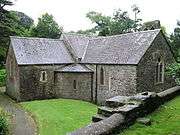Isfael
| Saint Ismael | |
|---|---|
| Bishop of Rhos | |
| Feast |
June 16[1] June 25 (at Uzmaston[1]) |
| Patronage | St. Ishmael's in Pembrokeshire and Carmarthenshire; Rhos |
Isfael or Ismael (Old Welsh: Ysmail), often anglicized as Ishmael, was an AD 6th-century medieval Welsh bishop of Rhos and saint. He was allegedly also a Breton prince of Armorica.
Although his anglicized name invites association with the Biblical Ishmael,[2][3] Isfael is actually a native Welsh name[1] (or even epithet) meaning 'under prince'.[4]
Isfael was said to have been the son of Budig ap Cybydan, a native of Cornouaille and eventual king of Armorica, and the brother of the martyr Tyfei and Bishop Eudoggwy (Oudoceus) of Llandaff.[5] His mother may have been Arianwedd, the daughter of Saint Issel and the sister of Saint Teilo. In Rhygyfarch's hagiography, Isfael was said to have been one of the three principal disciples of Dewi Sant;[3][6][7] in the Book of Llandaff, he is also included among the students of Dubricius and Teilo[5] and said to have succeeded David as the bishop of Menevia (St David's). (Since he does not appear in that parish's records, it was Rees's opinion that he was at most a suffragan bishop under Teilo.[5]) His eventual see was in Rhos at present-day St Ishmaels.
The parish churches of St Ishmael's in Pembrokeshire and Carmarthenshire and their surrounding communities are named in his honour. He was also the patron of the churches at Camrose, Rosemarket, Uzmaston, and (probably) Haroldston St Issells.[1] A valley or inlet in Carmarthen Bay was previously known as "St. Ismael's Scar".[8]
Gallery
-

St Ishmael's church, Pembrokeshire
-

St. Ismael's Church, Uzmaston.
-

St Ishmael's parish church, Camrose
References
- 1 2 3 4 Baring-Gould, Sabine & al. The Lives of the British Saints, Vol. 3 p. 323 f. Kessinger Publishing, 2005. Accessed 26 Mar 2013.
- ↑ Davies, John R. "Cathedrals and the Cult of Saints" in Cathedrals, Communities and Conflict in the Anglo-Norman World, p. 248. Boydell Press, 2011. Accessed 26 Mar 2013.
- 1 2 Sharp, Richard & al. (trans.) "Rhygyfarch's 'Life' of St David" in St David of Wales: Cult, Church and Nation, p. 121. Boydell Press, 2007. Accessed 26 Mar 2013.
- ↑ Sheard, K.M. Llewellyn's Complete Book of Names, p. 295. Llewellyn Worldwide, 2011. Accessed 26 Mar 2013.
- 1 2 3 Rees, W. J. (trans.) Liber Landavensis, pp. 351 & 370 ff. Welsh MSS. Society (Llandovery), 1840. Accessed 26 Mar 2013.
- ↑ Davies, John R. The Book of Llandaf and the Norman Church in Wales, p. 88. Boydell Press, 2003. Accessed 26 Mar 2013.
- ↑ Jones, William B.T. The History and Antiquities of Saint David's p. 244. Parker, Smith, & Petheram (London), 1856. Accessed 26 Mar 2013.
- ↑ The Royal Commission on the Ancient and Historical Monuments and Constructions in Wales and Monmouthshire. An Inventory of the Ancient Monuments in Wales and Monmouthshire, "Vol. V.—County of Carmarthen.", p. 245. His Majesty's Stationery Office (London), 1917. Accessed 26 Mar 2013.